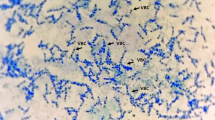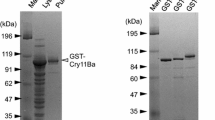Summary
Clostridium bifermentans serovar malaysia is toxic to mosquito larvae. During large-scale preparation in a fermentor, the bacteria enter the sporulation stage after 5 h culture, whereupon high larvicidal activity is obtained (LC50 48 h on Anopheles stephensi = 3.1 × 10−5). The toxicity becomes maximal around 3–5 h later (LC50 48 h = 1.3 × 10−5) and remains unchanged until sporangium lysis. An important loss of toxicity is then observed when the cells lyse. This loss appears to be due to the fact that C. bifermentans serovar malaysia synthesizes and excretes, mainly during vegetative growth, metallo- and/or cystein-proteinases, which are active between pH 6.0 and pH 8.0. Extracellular proteinases are most likely responsible in large part for the decrease in toxic activity concomitant with cell lysis. Lysis is however prevented by addition of 10 mM ethylenediaminetetraacetic acid to the culture medium before forespore formation, and under these conditions the larvicidal activity can be maximized.
Similar content being viewed by others
References
Allison C, McFarlane GT (1988) Comparative studies on proteases formed by Clostridia isolated from human feces. In: Hartman PA, Morello JA (eds) Abstract of the Annual Meeting of the American Society for Microbiology. ASM Washington, DC, p 217
Barjac H de, Larget-Thiery I (1984) Characteristics of IPS82 as standard for biological assay of Bacillus thuringiensis H14 preparations. WHO Mimeogr Doc WHO/VBC/84.892
Barjac H de, Sebald M, Charles JF, Cheong W, Lee HL (1990) Clostridium bifermentan serovar malaysia, une nouvelle bactérie anaérobie pathogène des larvaes de moustiques et de simulies. C R Acad Sci [III] 310:383–387
Barrett AJ, Salvesen G (1986) Proteinase inhibitors. Elsevier, Amsterdam
Berry C, Jackson-Yap J, Oei C, Hindley J (1989) Nucleotide sequence of two toxin genes from Bacillus sphaericus IAB59: sequence comparisons between five highly toxinogenic strains. Nucleic Acids Res 17:7516
Broadwell AH, Baumann P (1986) Sporulation-associated activation of Bacillus sphaericus larvicide. Appl Environ Microbiol 52:758–764
Charles JF, Nicolas L, Sebald M, de Barjac H (1990) Sporulation, biogenesis of inclusion bodies of Clostridium bifermentans serovar malaysia and larvicidal activity on mosquitoes. Res Microbiol 141 (in press)
Höfte H, Whiteley HR (1989) Insecticidal crystal proteins of Bacillus thuringiensis. Microbiol Rev 53:242–255
Lisansky SG (1989) Biopesticides. AgBiotech News Information 1:349–353
Sneath PHA, Mair NS, Sharpe ME, Holt JG (1986) Bergey's manual of systematic bacteriology, vol 2, Williams and Wilkins, Baltimore
Tomarelli RM, Charney J, Harding ML (1949) The use of azoalbumin as a substrate in the colorimetric determination of peptic and tryptic activity. J Lab Clin Med 34:428–433
Author information
Authors and Affiliations
Additional information
Offprint requests to: L. Nicolas
Rights and permissions
About this article
Cite this article
Nicolas, L., Hamon, S., Frachon, E. et al. Partial inactivation of the mosquitocidal activity of Clostridium bifermentans serovar malaysia by extracellular proteinases. Appl Microbiol Biotechnol 34, 36–41 (1990). https://doi.org/10.1007/BF00170920
Received:
Accepted:
Issue Date:
DOI: https://doi.org/10.1007/BF00170920




